|
Mary McKay Lindsay
1896 – 1991
Mary Lindsay was born in
Forfarshire, Scotland, a land which seems to produce a lot of good livestock
people. In 1906, with her parents, James and Margaret, and her siblings William,
James, Emma and David, she came to Canada
to the Furness district in Saskatchewan, south
of Lloydminster, the Barr Colony settlement on
the border between Saskatchewan and Alberta. The Lindsay’s
next herded their livestock, which included sheep, and took their goods and
chattels north of Lloydminster to land near Greenstreet Lake, close to the hamlet of Greenstreet.
They bought the Harry Pick
homestead. It was he who wrote a book, a very good book, on his homesteading
years. It seems a bit ironic that the book had the apt title of “So Soon
Forgotten”, for indeed there have been those who should have kept the name of Mary
Lindsay (and of Bill and Eileen Lamont) at the forefront when ever the breed of
Speckle Park cattle is mentioned, but seem purpose driven to tell falsehoods
about the origin of the breed and not correctly mention the originators.
The family soon moved (1926) from
the log house to the big house, a handsome dwelling where they installed
electric lights and a coal burning furnace.
Mary was always drawn to animals
and to the outdoors. She admired good animals of any kind and in her clippings
had a picture if a beautiful Ayrshire cow,Bruchag Dora, and another of a fine
Blackface ram. The Lindsay’s livestock for a larger part appeared to have
Scottish origins: Galloway, Angus, Highland – but
they also had some Shorthorn and Jersey blood.
In 1929 Mary had her first
Highland animals brought to Canada,
six heifers and the bull “Major” and from this her herd grew. She also brought
in Texas
Longhorns.
It was in 1937 that she acquired
the heifer from Gus Formo family which became the very foundation cow of today’s
Speckle Park. The cattle that May kept from that heifer she called Linebacks.
Mary and Emma owned and raised
cattle in their own right. They milked by hand up to twenty cows from which
they sold the cream. People of today, including farm people now far
removed from those times, might not understand why they would get Jersey blood
into the herd through a Jersey bull bought by
Emma. The fact is that if the milk produced by the cows was richer, one would
receive a bigger cream cheque and that was vital.
Mary had a courteous relationship
with many people in the livestock world, from the local veterinarians to people
well-known in their day, such as Guy Weadick, Grant McEwan and, closer to home,
Alex Mitchell. Again notice the names of Scottish origin! The Lamonts too, had
come from Scotland
although Bill Lamonts wife, Eileen, came, alas! from English pioneers.
In the Big House Mary had a room
for the houseplants, which kept some greenery in the eye throughout the winter.
Mary, Emma, Jim and Dave didn’t marry but kept the home a place of hospitality
and managed, it could be said, a menagerie of animals and birds.
Ian McKenzie, son of Mary’s sister
Canadian-born Edith, wrote a poem in which he tried to put his Aunts life into
a “short story”. We do thank him for his generosity and trust in letting some
special selections from the clippings and photographs he collected from his Aunts life to be
used on this website.
Scattered throughout the scrapbook
were such items as pictures of the Royal Family, cows, horses, dogs, sheep, the
home, photographs of the like of Will Rogers, the cowboy philosopher, and the
obituary of R.D. Symons, the Englishman turned rancher, was also was an artist,
writer, and naturalist and more. The clippings kept by Mary show her interests
and one of the most telling of all shall end this little tribute!
“ A hundred years from now it will
not matter the sort of house I lived in, what my bank account was, or the truck
I drove – but the world may be different because I was important in the lives
of the animals and the creatures on this earth”
Author unknown
Mary Lindsay, true livestock
people salute you! You made a difference! And you deserve to be remembered!
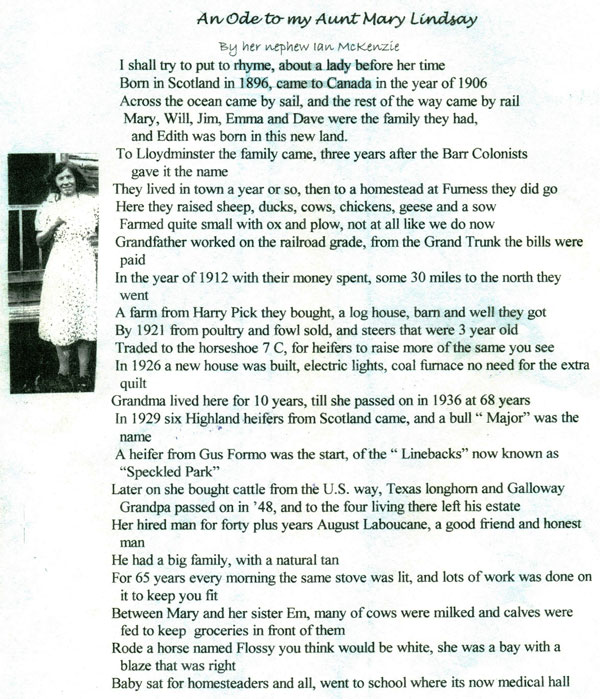
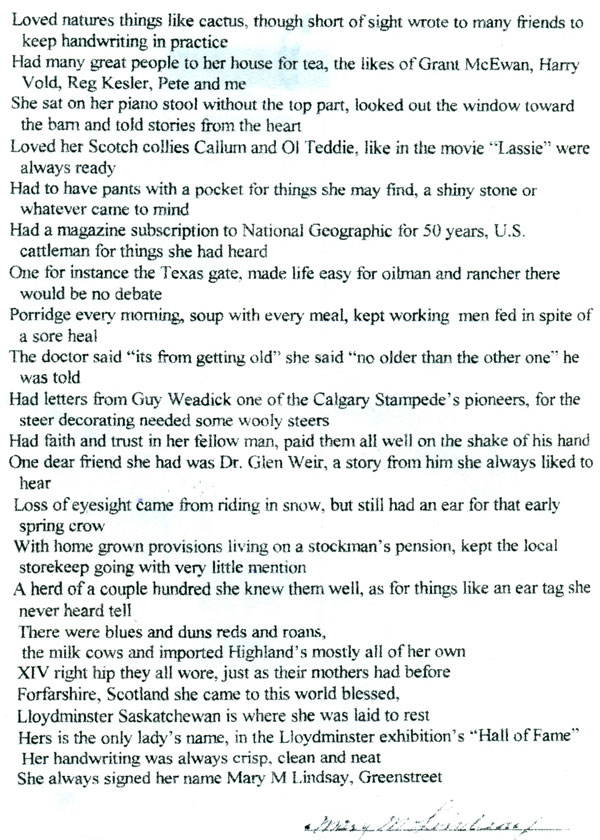
The Parents of Mary Lindsay
Margaret Lindsay mother of Mary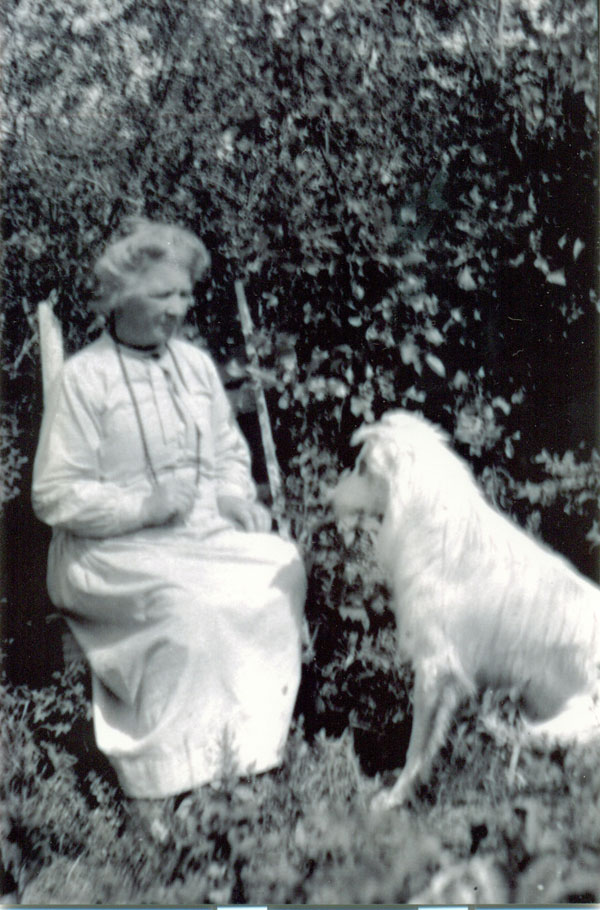
Mr. James Lindsay and the big house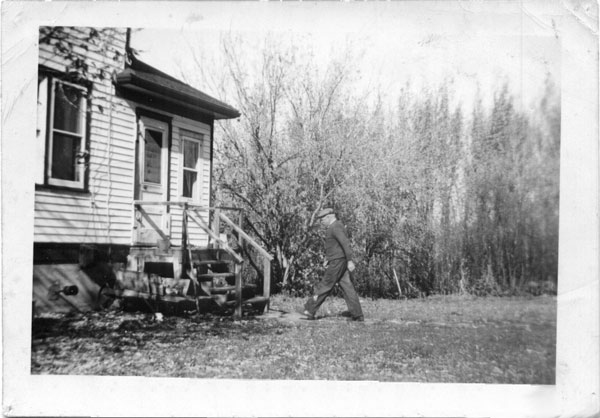
The Big House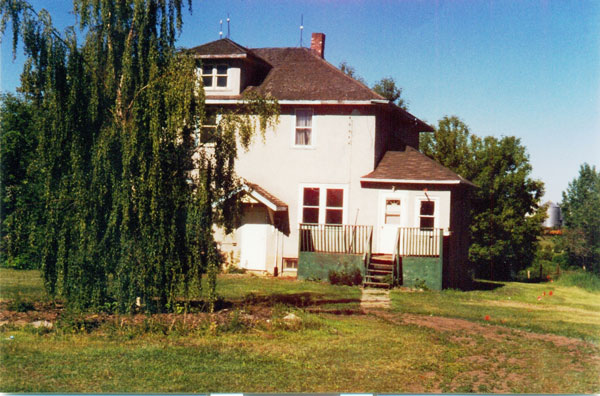
Mary Lindsay with dog Tippe
Emma and Mary Lindsay in later years
August Laboucane, the long time hired hand
Mr Lindsay on pinto horse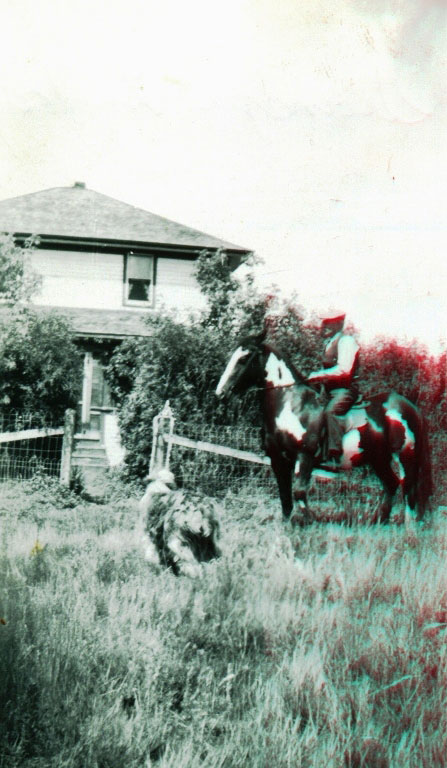
Pioneer helps bring Highland Cattle to Canada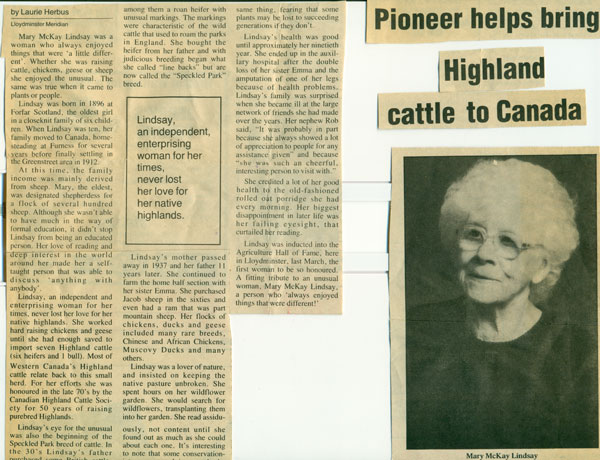
News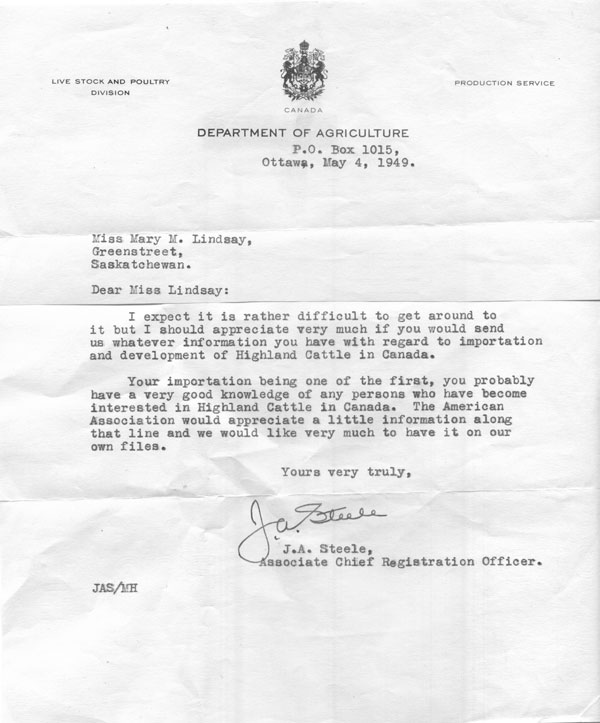
Hall of Fame Nominee - (people often refer to Speckled Park cattle as Speckle Park, an easily understood error)
Nomination Letter
Mary McKay Lindsay was born on the 21st of may in 1896 at the
Forfarshire, Scotland. Her parents, Margaret and James Lindsay had four other
children born to them in Scotland.
They were William, James (JIM), David and Emma. Their last child Edith was born
in Canada
In 1906 the Lindsay family moved to Canada
arriving in Lloydminster
in the month of June, Mary was ten years old .In the spring of 1907 the Lindsay
family took up a homestead at Furness. They lived there until they moved to Greenstreet in 1912. As a young girl Mary recalls working
for R.J.R. Noyes parents when Bob was still a small child. The Lindsay family
income in the late teens and early twenties was mainly derived from sheep
raising. It was at this time that Mary started to raise chickens. She
would dress them and sell them to the hotels and various eating establishments
in Lloydminster.
When she had enough saved she imported 6 highland heifers and one bull in 1929.
Most of western Canada's Highland cattle relate back to small herd Mary Lindsay
imported. In the late 70's Mary was honoured by Canada's
Highland cattle society for 50 years of
raising purebred Highlands.
In the 30's Mary's father
purchased some British cattle and amongst them was a roan heifer that caught
Mary's eye. It had the characteristic dark muzzle, ears and feet of the wild
cattle that roamed the parks in England.
She had bought it from her father. She called them "line backs"
because of their markings .Mary raised the line backs for many years. In 1959
Mary sold some to Mr Bill Lamont of Maidstone.
He bought more from Mary in the sixties and called them speckled park cattle.
They are now known as the speckled park breed. Mary also raised purebred Galloway’s in the 50's.
Mary's first land was a 1/2
section in Paradise valley which she purchased
in 1945. She rented another section and ran 60 head of cows on it. In the
spring of 1946 Mary Lindsay sold Paradise
valley land and bought 2 sections of land south east of Hillmond. She later
added another section.
Mary mother passed away in
1937 .James Lindsay Sr. passed away in 1948 leaving the home half section
jointly to his daughters Mary and Emma. The sister’s hand milked a herd of 20
cows for over 50 years. Mary took over her fathers flock of sheep in the
sixties .One of her rams was part mountain sheep.
Some of Mary's hobbies were
raising exotic chickens. She would have eggs shipped in from down east and
hatch them at home. She was a nature lover and loved wild flowers and cactus.
Mary Lindsay sold her last
cattle herd in 1979. She now resides at the Auxiliary
Hospital at Lloydminster.
This evening it gives the Lloydminster Agricultural Exhibition Society
great pleasure and honour to be induct Mary McKay Lindsay into its Hall of Fame
- A woman who dared to reach farther then her grasp.
The Highland Cow
Marag Buidhe 6-4-52
Breeder: Mary Lindsay
Owner: Bill and Betty Nolan
Senior and Grand Champion Female at the First All Scotch Highland Show 1964. 12 years Old!!
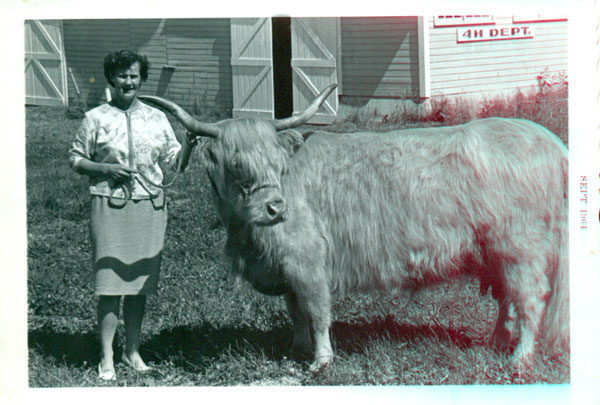
Mary's Sheep
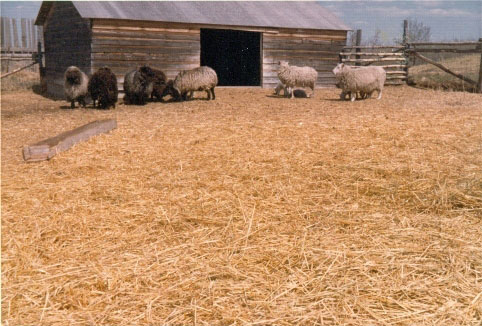
Highland Cattle
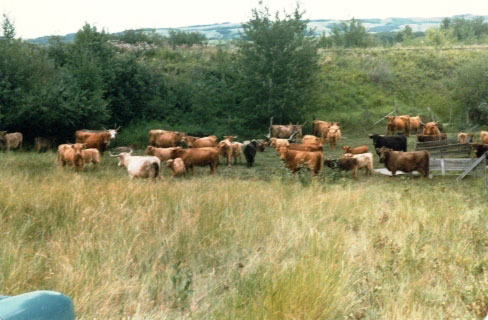
Letter
This letter mentions the Highland Heffers Bill wanted and the Lineback heifers Eileen wanted. This proves that, as Eileen claimed, she bought the first Lineback heifers from Mary.
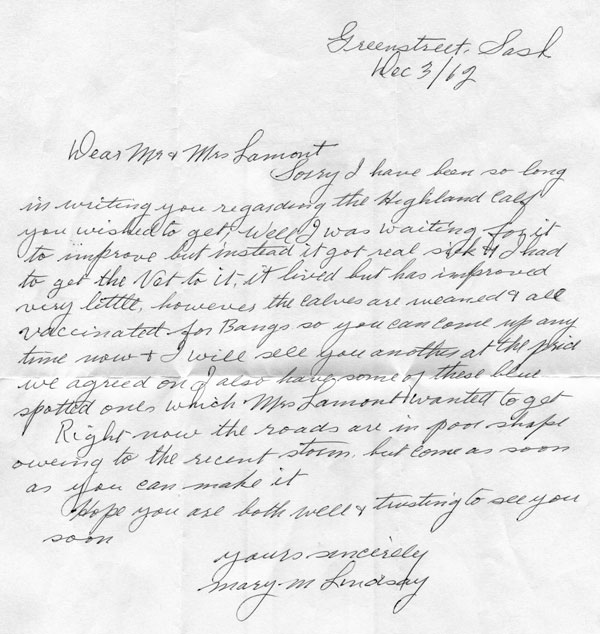
Lineback Cow
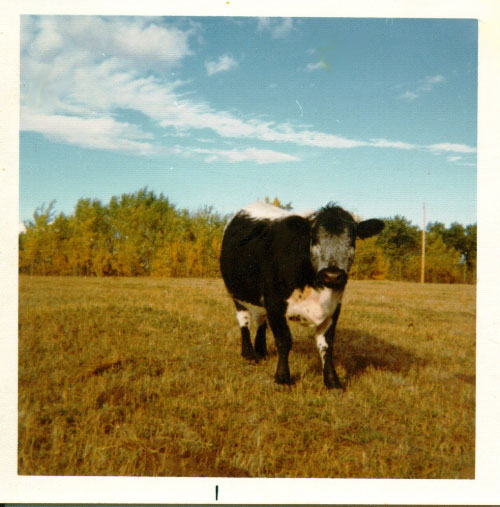
Mary Lindsay Honoured
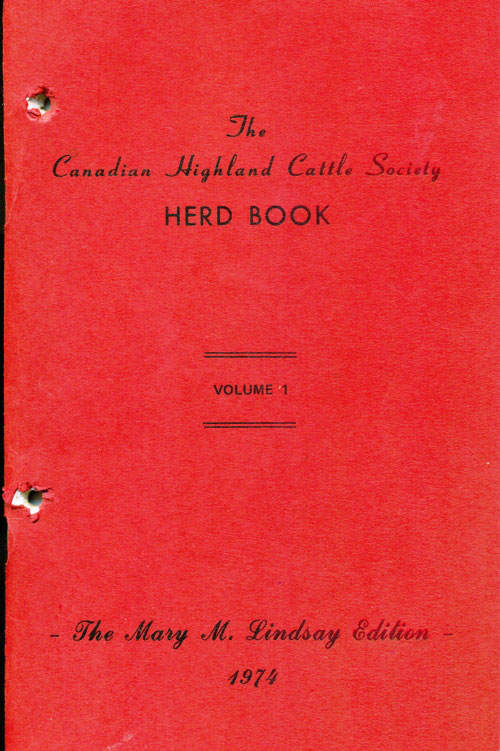
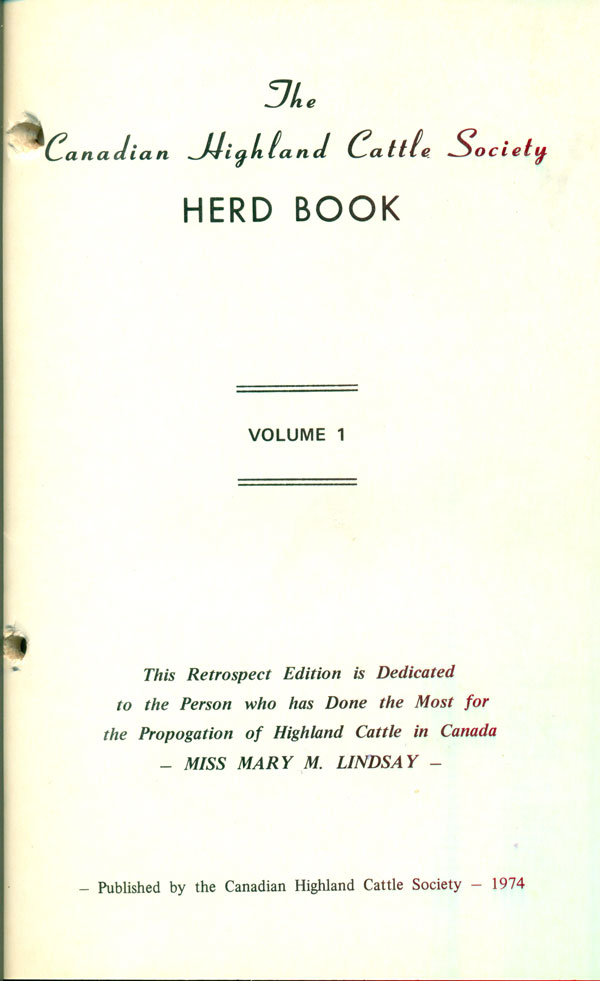
Postcard
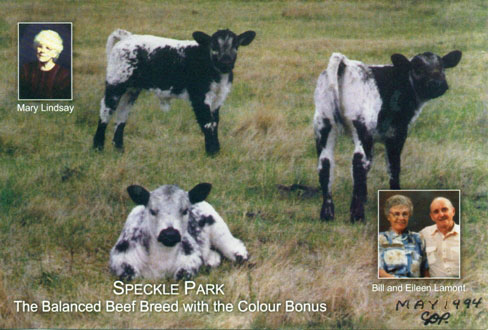
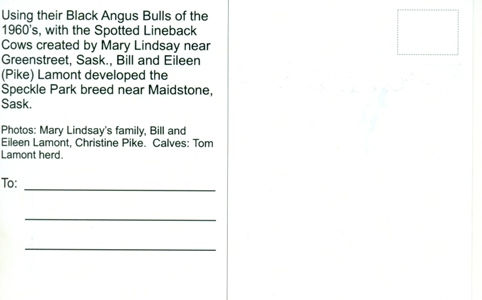
Speckle Park cattle continue to win carcass classes. REMARKABLE!! Congratulations to the owners!

|


![]()



















